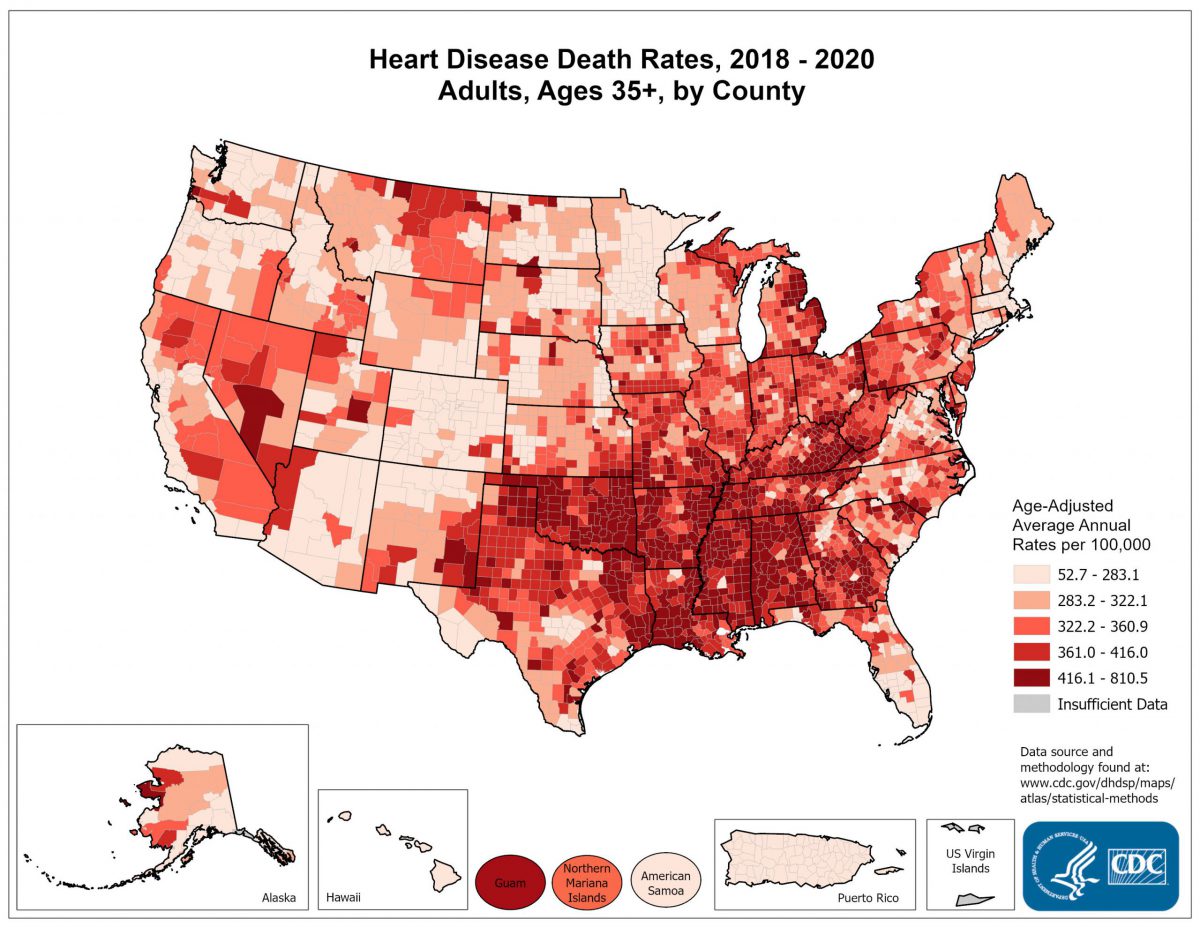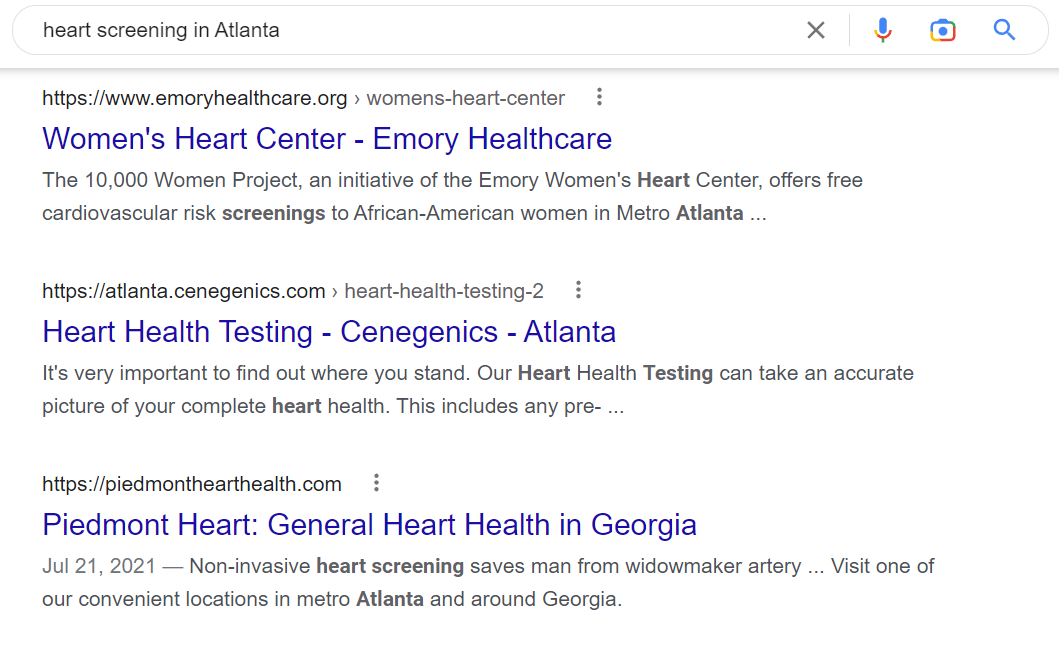According to the CDC, about 20.1 million U.S. adults age 20 and older have cardiovascular diseases. As cardiovascular risk factors and disease keep increasing in the United States, it represents a rising burden to the American healthcare system. It highlights the importance of early treatment and patient education to combat this dire situation.

Like many healthcare sectors, the COVID-19 pandemic hurt the cardiology industry due to the reduction of diagnoses of cardiovascular diseases since resources were reserved for COVID-19 patients. However, as we move on from the pandemic, cardiology patients are ready to resume their healthcare journey, and procedure volumes are bound to recover.
With that said, the demand for cardiology services will remain high, and competition will only keep getting tighter. Therefore, providers need multi-faceted digital marketing for cardiologists, including strategies like SEO, Google Ads, Facebook Ads, conversion rate optimization, web design, and reputation management.
Build an Optimized Cardiology Website
All digital marketing efforts start with your cardiology website–your digital front door and your primary marketing tool. Most of your patient’s first interaction with your brand is through your website, so it needs to be well-designed, optimized for content discovery, and has a strong groundwork for SEO.
Website Design for Cardiology Best Practices
Robust web design means your digital front door should be able to provide a comfortable user experience–think of easy-to-read fonts, intuitive menus, professional images, and searchable content. In addition, your cardiology website should have prominent call-to-actions (CTAs) to guide visitors toward the next conversion step.
According to recent statistics, 59% of global website traffic is from mobile devices. Plus, 61% of mobile users will abandon a website if it doesn’t have a mobile-supported version. These stats highlight the importance of having a mobile-friendly website. Healthcare providers should have a mobile-friendly website that sports a responsive design, meaning it displays correctly regardless of the screen it’s being viewed on.
Besides mobile optimization, your website, in general, should load fast and offer intuitive navigation. You’re improving visitor retention and conversion rates with an optimized cardiologist website focusing on user experience.
Key Content Discoverability and Visibility
High-quality, patient-centric content can provide healthcare brands a full range of benefits. However, your website content should be easily discoverable, so patients can easily find the information they need. Thus, avoid hiding key content behind menus, multiple links, and confusing navigation. If people can quickly find your cardiology-related content, you’ll have more opportunities to cultivate new leads and patients.
With the recent Helpful Content Update by Google, the need for valuable and appealing content is more crucial than ever. Your entire cardiology website should have a content library organized around patient needs and focuses on providing the top-notch user experience that patients seek.
Streamline the Appointment Process
Many people will need your cardiology services, from screening to Cardiothoracic surgery, so you must make it easy for potential patients to ask questions or reach your office. Consider using chatbots or live chat software and integrating click-to-call phone numbers in your site for people who want to talk to a representative.
Meanwhile, investing in online scheduling systems will make it easy for patients to book appointments. These systems can drastically reduce phone calls and afford you more control with a virtual scheduling assistant. As a result, you’re providing a highly-accessible method of booking appointments for patients, so your team can focus on better care delivery.
Leverage Local SEO for Cardiologists
Did you know that “near me” healthcare-related searches have doubled since 2015? For many healthcare groups, the arena is in the local market. Despite the trend of private equity consolidations, cardiology is predominantly a local service, and providers rely on attracting patients in their geographical area. By the same token, patients want to work with a nearby cardiology center instead of traveling for miles.
Best Local SEO Practices
Below are some high-level strategies to improve your local search visibility:
Citations & Listings
You can start your winning local SEO strategy by making high-quality listings and citations on various local and national directories such as Yelp, Healthgrades, and ZocDoc. In addition, you may also register your practice in niche cardiology directories such as the American College of Cardiology. The best approach to optimize your listings is to provide accurate and complete information (e.g., practice name, address, and phone number (NAP)).
Google Business Profile (GBP) Optimization
Billions are using Google Maps every month when looking up a local business address. Meanwhile, businesses with Google Business Profile or GBP (formerly Google My Business) listings are 70% more likely to attract customers for in-store visits than those that don’t.
So what do these stats tell us?
Google profiles are essential tools for any healthcare business, including cardiology centers and clinics. If you haven’t already, claim, populate, and optimize your GBP. Make sure you provide critical information about your cardiology practice, such as:
- Practice name
- Address
- Contact information (phone number, email)
- Operational hours
- On-site photos
- A blurb about your practice
Another excellent tip is to populate your profile with frequently asked questions or FAQs that answer patient questions. Write the FAQs with details about your services, treatments, pricing, and insurance information.
Local SEO Keyword Strategy
Think about the local SEO keywords you wish to rank for. While developing your keyword list, hone in on your unique selling proposition or USPs, how your patient searches for your services, and of course, your target area. Typically, local SEO keywords are:
- High-intent, solution-aware: the person knows they need the services of a cardiology doctor.
- Location-based: these are long-tail key phrases with geographical identifiers such as “heart screening in Atlanta”
The key to effective and efficient local SEO keywords is to be specific and granular as possible because of less competition.

Personalized Location Pages
Multi-location cardiology groups can genuinely benefit from personalized location or landing pages. Patients appreciate personalized experiences because they have unique healthcare needs and circumstances. This means you must create landing pages for each geographical location or affiliate. However, don’t make the mistake of simply using your on-site copy for these pages.
With that said, ensure each location page has a personalized touch with patient-centric content that addresses the real concerns of searchers. For instance, you can embed a map on the landing page that shows the address and driving directions. You may also include high-quality video production to add more value to your landing page experience.
Total Alignment: Bridging the Gap Between Marketing and Operations
Let’s say: Your cardiology practice’s marketing team is working overtime, churning out campaigns that promise swift appointments and cutting-edge treatments. Meanwhile, your operations team is struggling to keep up with the influx of new patients, leading to long wait times and frustrated staff.
Sound familiar?
If so, it’s time to break down the silos and embrace total alignment between marketing and operations. Remember these alignment areas:
1. Capacity
Misaligned marketing efforts can result in an increase in patient dissatisfaction due to long wait times.
Actionable steps:
- Create a real-time capacity dashboard
- Hold weekly marketing-ops meetings
- Implement a flexible marketing budget that shifts based on capacity needs
But how does this work in practice? Imagine your cardiology practice has three locations. Location A is fully booked for the next month, while Locations B and C have immediate availability. With a real-time capacity dashboard, your marketing team can instantly shift their geo-targeted ads to focus on areas near Locations B and C, ensuring a steady flow of patients without overwhelming any single location.
2. Service Lines
Q: Which cardiology services should you prioritize in your marketing efforts? A: The ones that align with your practice’s strengths, profitability, and patient needs.
To identify your high-value service lines:
- Analyze patient lifetime value across different treatments
- Assess profitability of each service
- Consider potential for upsells or complementary services
Example: If your practice excels in preventive cardiology, focus your marketing efforts on attracting patients for long-term wellness programs rather than one-off diagnostic tests.
Let’s dive deeper: Say your data shows that patients who start with a heart health screening often go on to enroll in your cardiac rehabilitation program. This journey represents a high lifetime value. Promoting heart health screenings doesn’t just book appointments. It builds lasting relationships with patients and improves health outcomes.
3. Messaging
Consistency is key. Your receptionist, your nurses, your marketing materials–they should all be conveying the same message about your practice’s values and expertise.
Try this exercise:
- Gather representatives from marketing, operations, and medical staff
- Ask each to describe your practice’s unique value proposition in one sentence
- If the answers vary wildly, it’s time for a messaging alignment workshop
But don’t stop there. Once you’ve aligned your messaging, make it tangible. Create a “brand book” that goes beyond logos and color schemes. Include sample scripts for common patient interactions, FAQs with on-brand answers, and guidelines for communicating complex cardiac information in patient-friendly terms.
4. Technology
The right tech stack can transform a patient’s experience from fragmented to seamless, from their first awareness of your practice to their treatment and beyond. To achieve this, you’ll need some key tools:
- integrated CRM and EHR systems to manage patient information
- call tracking software with AI analytics to understand patient communication
- feedback platforms that inform both marketing and operations
However, be cautious when bringing in new tech. Without support from both marketing and operations, even the best tools can fail. Make sure to involve both teams when choosing and setting up new systems. This collaborative approach increases the chances of successful adoption and helps everyone see the benefits of the new technology.
Practical Steps: Making Alignment a Reality
To foster alignment between marketing and operations in your cardiology practice, focus on these core principles:
- Identify shared goals: Recognize that both teams aim for financial success and improved patient care.
- Understand each other’s perspectives: Take time to learn what matters most to each team and how you can support each other’s needs.
- Communicate clearly: Avoid jargon and explain concepts in simple terms that resonate with both marketing and operations staff.
- Meet regularly: Schedule frequent check-ins to ensure ongoing communication and collaboration.
- Listen to feedback: Be open to feedback and willing to adjust strategies based on what you hear.
- Practice empathy: Remember that everyone is working towards better patient care, often under challenging circumstances. Treat each team member with respect and understanding.
By following these principles, you’ll create a culture of alignment that benefits your entire practice and, ultimately, your patients.
Remember: Total alignment isn’t a destination; it’s a journey. Keep refining, keep communicating, and watch your cardiology practice thrive.
Invest in Google Ads for Cardiologists
There’s no better strategy for building brand awareness and quickly capturing the bottom of the funnel (BOF) leads than Google Ads or PPC marketing. Paid search activities will put your practice in front of patients ready to book an appointment by displaying your ads at the top of the Google SERPs by targeting high-intent, local keywords.
Google Ads Best Practices
If you want to make the most out of your paid search campaign, consider the following strategies:
Google Ads Account Structure
In this age of PPC automation, choosing the proper account structure is more crucial than ever. Based on my experience, many of our biggest clients have benefited from a hybrid account structure. This account structure combines consolidated and segmented ad groups, essentially giving you the best of both worlds.
Consolidated accounts are used for maximizing ad impressions and optimizing Google’s automated bidding strategies. On the other hand, a segmented account structure offers pinpoint targeting capabilities (generally by location) and better budget control.
Leverage AI-Powered Bidding
Google’s smart bidding algorithm is one of the best things to happen to PPC marketers. The AI-powered bidding system can bid more accurately and efficiently in many ways. However, with automation, it’s hard not to feel the loss of autonomy. The automation of bids promotes experimentation and makes it easy for marketers to optimize. This is why choosing the most suitable account structure for your PPC campaign is crucial.
Alignment of Ads With Search Intent
Another hallmark quality of a successful PPC campaign is the alignment of ad groups with keyword intent along the funnel. Thus, it always pays to have a diverse keyword strategy that covers all stages of the patient funnel–so don’t skip on your keyword research. Align your ads to cover the following funnel:
- Upper funnel “problem aware” leads: These people are researching and finding solutions. They’re not quite ready to meet a cardiologist, but they know they have cardiovascular issues. You should target lower-intent keywords like “early signs of heart disease in males” at this stage.
- Mid-funnel “solution-aware” leads: These people seek solutions but aren’t decided which treatments are right for them. For this stage, target keywords designed to educate patients, such as “best diet for heart disease reversal” or “heart procedures for blockage.”
- Lower funnel “product aware” leads: These people know they need to meet with a cardiovascular doctor and are ready for bookings. For this stage, your ads should target high-intent, product-aware keywords.
Brand Reputation Management for Cardiologists
Your online reputation can make or break your practice and is closely tied to your local SEO efforts. When searching for a local cardiovascular specialist in their area, people will read patient reviews prior to booking an appointment. True enough, 72% of patients use reviews and testimonials to evaluate healthcare providers. Your practice will likely receive more patient referrals and inspire WOM marketing if you have a sound online reputation.
This highlights the importance of brand reputation management.
Best Practices for Brand Reputation Management for Cardiologists
The simplest and most reliable way to get more reviews is to ask your patients after their appointment directly. Most patients will happily oblige, especially your regulars. Communicate the importance of their feedback and how it can help your practice, but don’t tell them to make something up. Train your staff in best practices and make it SOP to ask patients for reviews.
Furthermore, you’ll likely receive more reviews if you streamline the review process itself. Provide numerous ways to leave reviews and ensure they’re fast and easy to complete. Some good ideas are short patient surveys and follow-up emails.
Another excellent review-generation strategy is to purchase a reputation management tool like Podium, Birdeye, and Weave. They integrate into your CRM systems (e.g., email, SMS, etc.) and automate the collection of reviews. Plus, these systems give you more control when things go south. For example, when there’s a negative conversation about your practice, your marketing team can hop in to explain, clarify information and make amends.

Implement Marketing Analytics / Real-time ROI Measurement for Cardiologists
Believe it or not, launching your digital marketing campaign isn’t the most challenging part. In fact, the bulk of the work comes from fine-tuning your strategies to drive better results. Monitoring performance and key marketing analytics give you invaluable clarity to make better decisions. You’ll be in the best position to determine which marketing pieces are producing returns or not.
For many of our clients, we always recommend closed-loop reporting or CLR because it’s the gold standard for acquiring insights backed by reliable data. This reporting enables us to evaluate how each strategy impacts the patient journey (i.e., which leads are generating the most sales)
Best Practices for Data-Driven Marketing for Cardiologists
Start by integrating all your systems, including CRMs and EHRs (Search Console, Google Analytics, CRM system, etc.). Next, team collaboration will be easier and more productive with a centralized analytics dashboard. While you’re at it, focus on weeding out unnecessary organizational silos and improving team communication. Lastly, establish clearly-defined goals and KPIs to guide your digital marketing strategy accordingly.
Conclusion
Alright, cardiology marketers, these digital marketing strategies will help increase your patient base and accelerate practice growth. One key thing is to develop your digital marketing campaign around patient-centricity–aim to provide first-rate digital experiences with the best practices I outlined above to stay competitive and achieve your growth targets.

